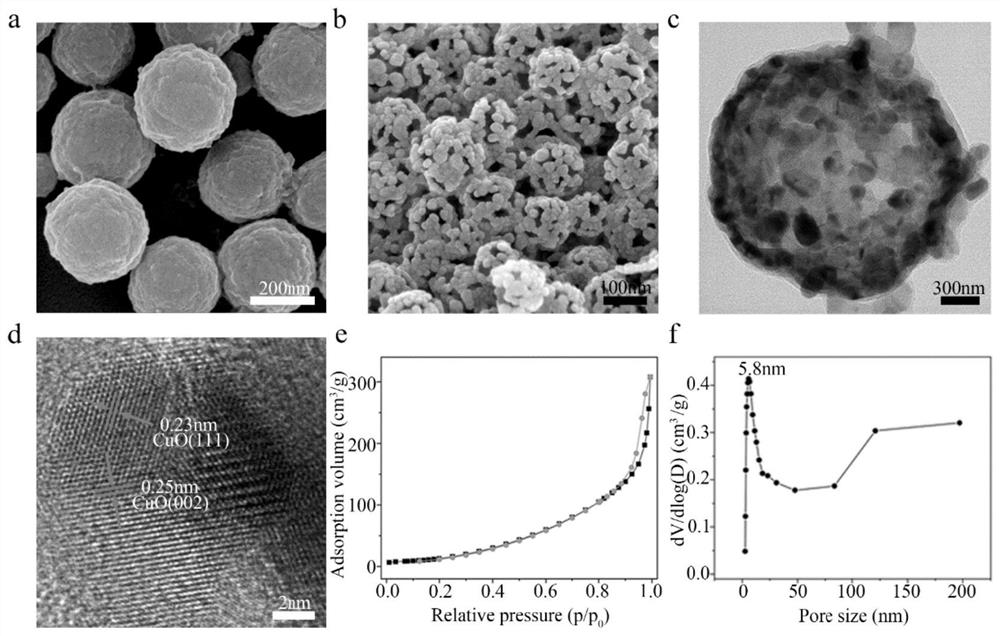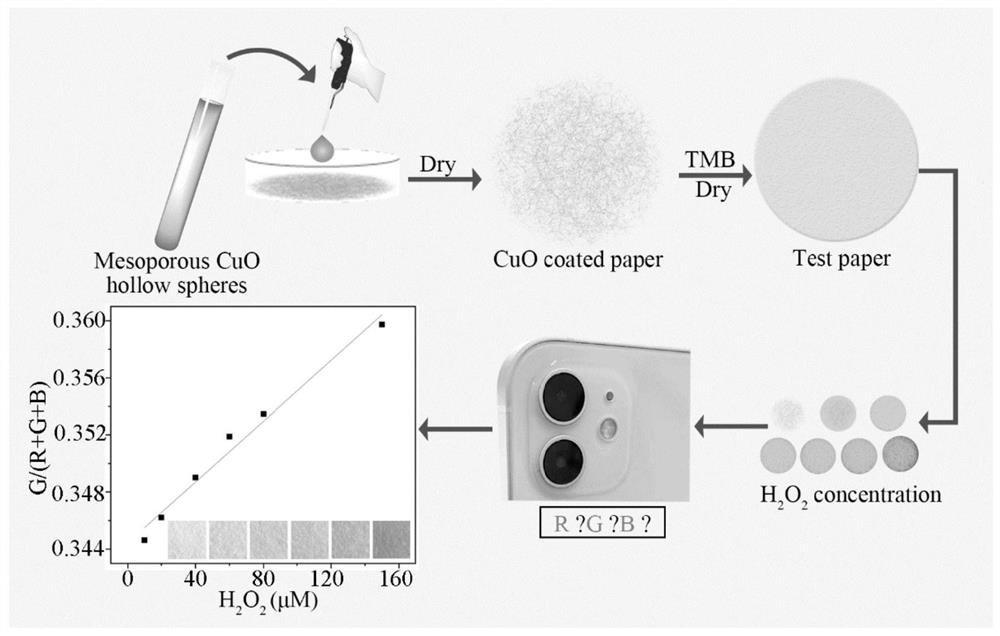Paper-based sensor for detecting H2O2 based on mesoporous CuO nano-enzyme, and preparation method thereof
A sensor and nanozyme technology, applied in the field of biomedical detection, can solve the problems of low portability, complicated operation, and high cost, and achieve the effects of strong universality, simple operation process, and high selectivity
- Summary
- Abstract
- Description
- Claims
- Application Information
AI Technical Summary
Problems solved by technology
Method used
Image
Examples
preparation example Construction
[0037] refer to figure 2 and 3 , a mesoporous CuO-based nanozyme for the detection of H 2 o 2 The preparation method of the paper-based sensor comprises the following steps:
[0038]Step 1. Dissolve the amphiphilic block copolymer F127, tannic acid (TA), and formaldehyde in an alkaline water / ethanol mixed solvent, and stir at room temperature for 12 to 24 hours to prepare a mixed solution; add nitric acid to the mixed solution After continuing to stir the copper aqueous solution for a certain period of time, the copper-tannic acid-formaldehyde polymer is obtained by hydrothermal and centrifugal collection, and the copper-tannic acid-formaldehyde polymer is roasted in air to obtain mesoporous CuO hollow nanospheres;
[0039] Step 2. Disperse the mesoporous CuO hollow nanospheres in a certain volume of aqueous solution, soak the paper in the CuO aqueous solution for a certain period of time, let it dry naturally at room temperature, then cut the paper and store it in a plast...
Embodiment 1
[0045] A mesoporous CuO nanozyme based on the detection of H 2 o 2 The preparation method of the paper-based sensor comprises the following steps:
[0046] Step 1. Preparation of Mesoporous CuO Hollow Nanospheres
[0047] S1.1. Dissolve the amphiphilic block copolymer F127 and tannic acid in a mixed solution of alkaline water and ethanol, then add formaldehyde, and stir at room temperature for 12 to 24 hours to prepare a mixed solution;
[0048] Dissolve 0.20 g block copolymer F127 and 0.20 g tannic acid in 48 mL H 2 In the mixed solution of O and 8mL absolute ethanol, add 0.35mL concentrated ammonia water after completely dissolving, slowly add 0.38mL formaldehyde solution after stirring for 5min, and add 2mL freshly prepared Cu(NO 3 ) 2 solution (the mass of the metal salt is 0.10g), continue to stir for 12h, and then place it in an oven at 100°C for 12h;
[0049] S1.2. Collect hydrothermal products by centrifugation at 8500rpm for 10min, then centrifugally wash with ul...
Embodiment 2
[0062] A mesoporous CuO nanozyme based on the detection of H 2 o 2 The preparation method of the paper-based sensor comprises the following steps:
[0063] Step 1. Preparation of Mesoporous CuO Hollow Nanospheres
[0064] S1.1. Dissolve the amphiphilic block copolymer F127 and tannic acid in a mixed solution of alkaline water and ethanol, then add formaldehyde, and stir at room temperature for 12 to 24 hours to prepare a mixed solution;
[0065] Dissolve 0.20 g block copolymer F127 and 0.20 g tannic acid in 48 mL H 2 In the mixed solution of O and 8mL absolute ethanol, add 0.35mL concentrated ammonia water after completely dissolving, slowly add 0.38mL formaldehyde solution after stirring for 5min, and add 2mL freshly prepared Cu(NO 3 ) 2 solution (the mass of the metal salt is 0.10g), continue to stir for 12h, and then place it in an oven at 100°C for 12h;
[0066] S1.2. Collect hydrothermal products by centrifugation at 8500rpm for 10min, then centrifugally wash with ul...
PUM
| Property | Measurement | Unit |
|---|---|---|
| specific surface area | aaaaa | aaaaa |
| particle diameter | aaaaa | aaaaa |
| specific surface area | aaaaa | aaaaa |
Abstract
Description
Claims
Application Information
 Login to View More
Login to View More - R&D Engineer
- R&D Manager
- IP Professional
- Industry Leading Data Capabilities
- Powerful AI technology
- Patent DNA Extraction
Browse by: Latest US Patents, China's latest patents, Technical Efficacy Thesaurus, Application Domain, Technology Topic, Popular Technical Reports.
© 2024 PatSnap. All rights reserved.Legal|Privacy policy|Modern Slavery Act Transparency Statement|Sitemap|About US| Contact US: help@patsnap.com










